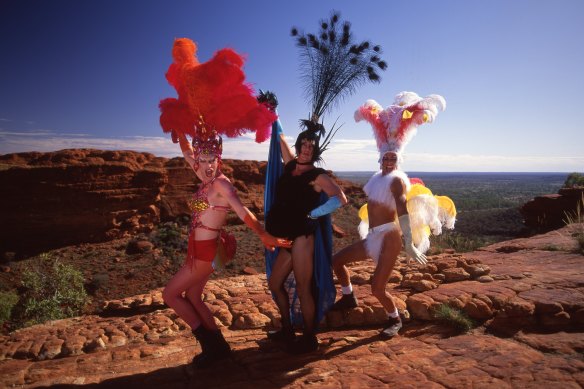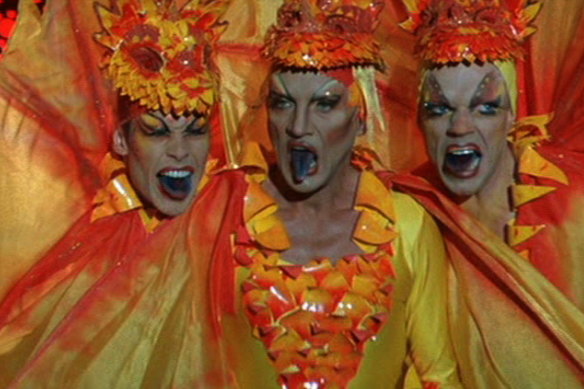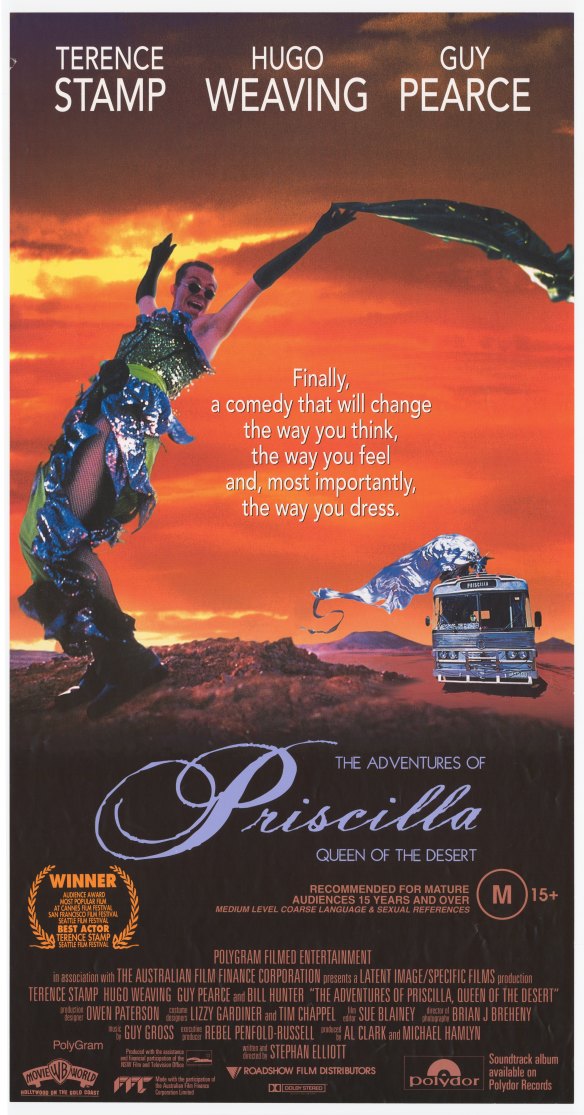This was published 11 months ago
Priscilla at 30: How queens of the desert made Australian film history
The people who created a cinematic legend relive the colour and chaos behind the scenes - and how one casting misstep might have changed everything.

Credit: Elise Lockwood, courtesy of the National Film and Sound Archive
At almost 1.45am on Monday, May 16, 1994, the closing credits rolled on the midnight screening of The Adventures of Priscilla, Queen of the Desert, in the 1068-seat Theatre Debussy, in the Palais des Festivals in Cannes, France.
The Cannes Film Festival audience rose to their feet and applauded for more than 10 minutes, an assurance that the film - the story of two drag queens and a transgender woman on an odyssey of self-discovery across the Australian outback - was more than just 103 minutes of colourful images and songs.
On that night, in the south of France, a new chapter was written in Australia’s film history. One that delivered to writer/director Stephan Elliott, producer Al Clark and executive producer Rebel Penfold-Russell - armed with just a script, a dream and a scraped-together budget - one of cinema’s greatest triumphs.
But the film’s success was by no means a certainty. It was an ambitious premise to pitch to investors and studios. And, on the eve of its release, the US ABBA Fan Club went to war against the film, labelling it “disappointing and disgusting” in a fierce protest campaign.
“We thought simply that it had a shot at being an original piece of entertainment with an enduring life without having any idea what kind of enduring life it would have,” Clark says, speaking, with other key creatives who worked on the film, on the eve of the film’s 30th anniversary.
“I was confident that Stephan would direct a comedy, having written it, that was funny and affecting, and that if we did it right it would last for as long as it lasted,” Clark adds. “But the main consideration, in neon-lit capitals, was make it funny, make it poignant, make it good and make it transcendent.”
The story of Priscilla actually begins five years earlier, in the production office of the television soap E Street. It was here that the film’s costume designers, Tim Chappel and Lizzy Gardiner, honed their craft, a blend of technicolour-meets-pop-music, on a very modest budget. That algorithm would be the making of Priscilla.
With no rule book, Chappel learned to create without fear. Or money, for that matter. “I didn’t know any better, so I didn’t know what was standard and what was required,” Chappel says. “I just knew what I wanted to do and Lizzy would let me do it.”
The same lack of fear was the “special sauce” in Elliott’s writing, Clark says. Writing about the making of the film back in 1995, Clark observed that the script had “just jumped out of Stephan’s head, which is why neither the concept nor the characters had a chance to be emasculated before they reached the page”.
“That’s a useful departure point because fear is one of the most inhibiting features of all [in the process of writing a feature film], if allowed to take control,” Clark says now.
The partnership of Chappel and Gardiner was also the first part of a tapestry that was beginning to stitch itself into being. Gardiner had been best friends with Elliott since they were kids. “There was never a time that I wasn’t aware of Priscilla,” Gardiner says. “All of Stephan’s screenplays were great, but Priscilla was special from the beginning.”
Elliott, in turn, had been staying with Penfold-Russell and her then husband, cinematographer Stuart Quin, who were producing another of Elliott’s films, Frauds. “The house was a laboratory,” Penfold-Russell says.
Their co-producer on Frauds was Andrena Finlay, whose husband, Clark, with Michael Hamlyn, became producers of Priscilla. Clark recruited cinematographer Brian J. Breheny and packed Breheny, Elliott and himself into a rented four-wheel-drive and embarked on a 1993 road trip to map the film’s bus route across Australia.
“On the journey, naturally, we discussed a lot of films and I thought about a lot of films because you can’t do that length of journey across Australia without doing so,” Clark says. The trio laughed a lot, he says. And sang.
At one point, as the car roared across the vast outback, they hummed the main themes from Lawrence of Arabia by Maurice Jarre and Born Free by John Barry. Those two films, particularly, would become cinematic touchstones for Priscilla.
Across the world, meanwhile, a casting call had gone out for the film’s main protagonists: Anthony “Tick” Belrose and Adam Whitely, better known as Mitzi Del Bra and Felicia Jollygoodfellow, and transgender performer Bernadette Bassenger.
In mind for the three roles were INXS lead singer Michael Hutchence as Tick, Strictly Ballroom star Paul Mercurio as Adam, and American film legend Tony Curtis as Bernadette. More astonishing is how close to reality that trio came. At different times, all three were legitimate contenders.
Rupert Everett was next up as Tick, with Jason Donovan as Adam and - sit down before you read this - Monty Python star John Cleese as Bernadette. Everett and Donovan considered, but ultimately passed, though Donovan would return as Tick in the film’s second life, as a stage musical. Cleese was a flat no.
More names came and went: Kyle McLachlan, Rupert Graves, Colin Firth and Matthew Broderick (for Tick), and Peter O’Toole, Richard Harris and Albert Finney (for Bernadette). At one point the Hollywood agency William Morris even suggested Julie Andrews, Ann-Margret and Lily Tomlin.
“The chemistry of the three was so fundamental that we could never come up with a name without correspondingly judging that name against the kind of people we may have notionally cast in other roles,” Clark says.
To me, the film has survived because Australia has always been about a fair go, and Priscilla is about kindness to each other.
Executive producer Rebel Penfold-Russell
And then suddenly Hugo Weaving was attached to Tick, and British film actor Terence Stamp - best known as General Zod in Superman - to Bernadette. “When we got to Terence, it all seemed to start happening,” Clark says. Stamp in turn suggested Bill Hunter for Bob, the outback mechanic who falls in love with Bernadette. And at the last moment, and with Gardiner and Chappel’s enthusiastic endorsement, former Neighbours star Guy Pearce entered the frame as Adam.
While all of this was happening, Penfold-Russell had been working on a documentary called Ladies, Please! Written and directed by Andrew Saw, it was the story of legendary drag queen Cindy Pastel (Ritchie Finger), drag/performance artist Strykermeyer (Mark Fitzhugh) and Lady Bump (Stuart Garske).
The documentary powerfully explored Australia’s drag culture, haunted by the aftermath of the AIDS epidemic, touching on the personal lives of its subjects, in particular Cindy Pastel’s relationship with his wife Kerrin and son Adam, which had inspired Priscilla’s Tick.
But the cameras did not just focus on the intersection between reality and fiction, they also followed their subjects – in particular, Strykermeyer – to Cannes, for the film festival. The result was a strange but intriguing mesh of documentary and living history. “It wasn’t done as proof, it was done to celebrate the people we were making a film about,” Penfold-Russell says.
Chappel, who had worked in his early years designing gowns for drag artists, describes the documentary as “a capsule of what drag was like in Sydney at the time, and how it was being expressed. Stryker was a huge influence on the makeup of the film, and Cindy was of course the subject of the main character.”
On the eve of the film’s 40-day shoot, Weaving, Pearce and Stamp were given makeovers and sent out, along with Clark, Elliott and other members of the crew, for a night on Sydney’s Oxford Street, visiting popular gay venues Gilligan’s and DCM. In the chaos that followed, each transformed almost immediately into their on-screen alter-egos.
“It was an attempt to give the actors a transcendent moment, where in costume and in a location consonant with their roles, they would have an opportunity of feeling ‘it’, whatever ‘it’ happened to be,” Clark says.
“The groundwork that led to it was of equal, if not greater importance because without that, that moment would not have had the kind of potency that it did,” Clark adds. “But sure enough, and aided by tremendous quantities of drinking, it was absolutely and irreversibly and forever a great moment.”
Once filming was underway, however, Stamp struggled. “I think he just thought you just put on a dress and turn into Audrey Hepburn, and it wasn’t the case at all,” Gardiner says. “There were some moments there where it was a little bit tense. But he also just disappeared into the character of Bernadette as well, as much as he possibly could.”

From left, Guy Pearce, Terence Stamp and Hugo Weaving in frill-necked lizard costumes.Credit: Elise Lockwood, National Film and Sound Archive
Chappel, who was big on spectacle, felt the three actors gave him permission to do whatever he wanted. The results ranged from the film’s iconic “Gumby” costumes to Pearce, clad in silver, on the top of the Priscilla bus, miming to Joan Carden’s performance of Sempre Libera (“Always Free”) from Act I of Verdi’s La Traviata.
“I felt unleashed as a designer to do whatever I wanted,” Chappel says. “The thing is, I’ve never really had much desire to wear the costumes. I’d much rather give my actor the tools they need to make an interesting character, and then sit back and watch it all unfold. There’s such joy in that.”
With one small exception, Clark reveals. In the long shot of the La Traviata scene, it is in fact Chappel in Pearce’s costume, as Pearce (along with Weaving and Stamp) was filming the scene in which the trio ascend King’s Canyon on the same afternoon.
“It was just magical, flying along the desert, miming,” Chappel says. “I was actually laughing my head off as well because it was such a delirious experience. I was trying to mime, and laughing at the same time. It was very joyous.”
The Adventures of Priscilla, Queen of the Desert opened in Australia on September 8, 1994. The film earned almost $20 million, and remains the 19th most successful Australian film at the local box office. Chappel and Gardiner won the Oscar, BAFTA and AACTA for their work.

Australian daybill poster for The Adventures of Priscilla, Queen of the Desert.Credit: National Film and Sound Archive
Unsurprisingly, it was adapted into a successful stage musical - though the music mix has changed in various productions and tours. For the original film, there were moments in its gestation when it might have been dominated by the songs of Shirley Bassey, or Kylie Minogue, or even Stock, Aitken and Waterman.
In the end the film was a mix of American R&B and disco, blending hits like I Love the Nightlife, I Will Survive, ABBA’s Mamma Mia and the song that would prove to be the movie’s enduring emotional anchor, Charlene’s I’ve Never Been To Me; its inclusion was only made possible by an 11th-hour deal for the film with Motown Records.
I’ve Never Been To Me, about a woman who has experienced everything but failed to find self-fulfilment, and its spoken-word bridge, about her realisation that her husband and child are the fulfilment she has been searching for, taps into a melancholy that pervades the film.
Because for all its colour, musicality and frivolity, The Adventures of Priscilla, Queen of the Desert is also a dark journey into the soul, as Tick faces up to his responsibilities as a father, Bernadette finds in Bob a fragment of love in the darkness of her grief, and Adam transitions from irresponsible boy to man.
“It is vulnerability that gives comedy its edge,” Clark says. “It brings to the film immediately another dimension, and I think we were conscious, but not over-conscious, of the extent to which each of the three characters’ vulnerability was going to be a factor in the whole evolution of the story.”
Three decades on, the film’s place in Australia’s cultural history is assured. “To me, the film has survived because Australia is a country which has always been about a fair go, and Priscilla is about kindness to each other, and that everybody deserves a family and love, no matter what,” Penfold-Russell says. “That is the eternal message of this film.”
And for Nathan Sanders, the former president of the US ABBA Fan Club, and fierce opponent of Priscilla? Now a playwright and screenwriter, we thought time - and a gentle nudge from us - might open up the possibility of healing old wounds. At our suggestion, Sanders revisited the film and sent this message: “Please let Priscilla know, all is forgiven.”
And that, folks, is what they call a happy ending.
RMIT hosts a screening of Priscilla with panel Q&A on September 11 at The Capitol in Melbourne; rmit.edu.au/events. The National Film and Sound Archive hosts a screening and panel Q&A on September 4, at the Arc Cinema in Canberra; http://nfsa.gov.au/events.